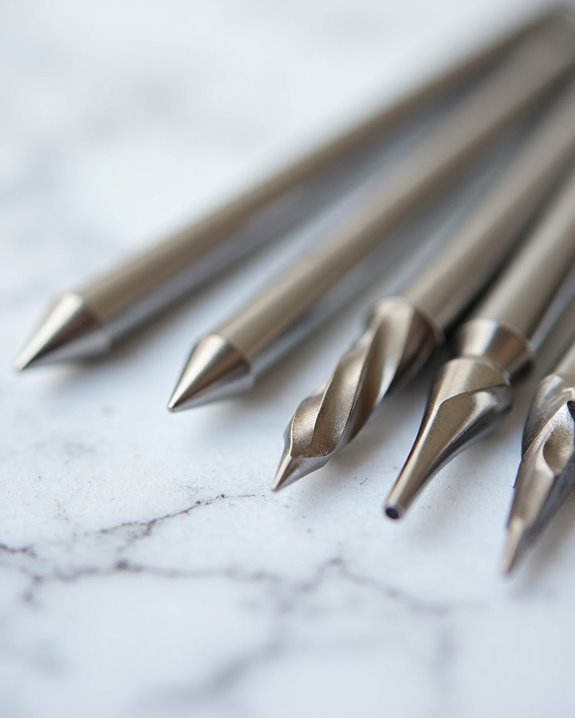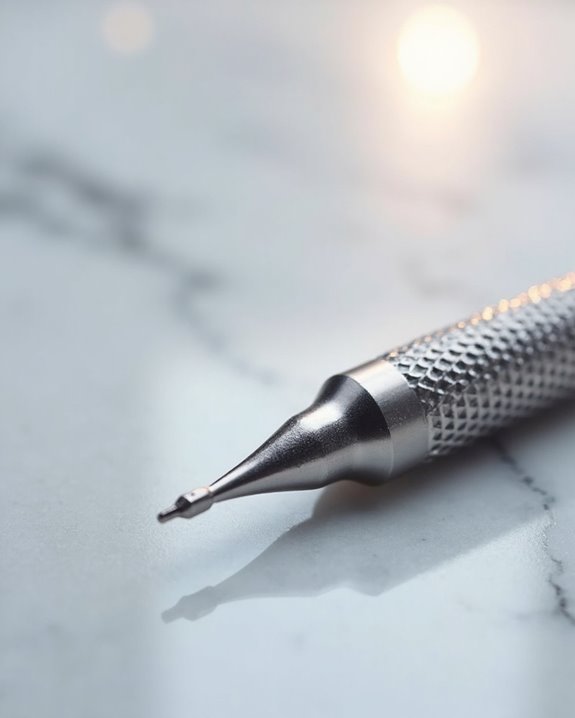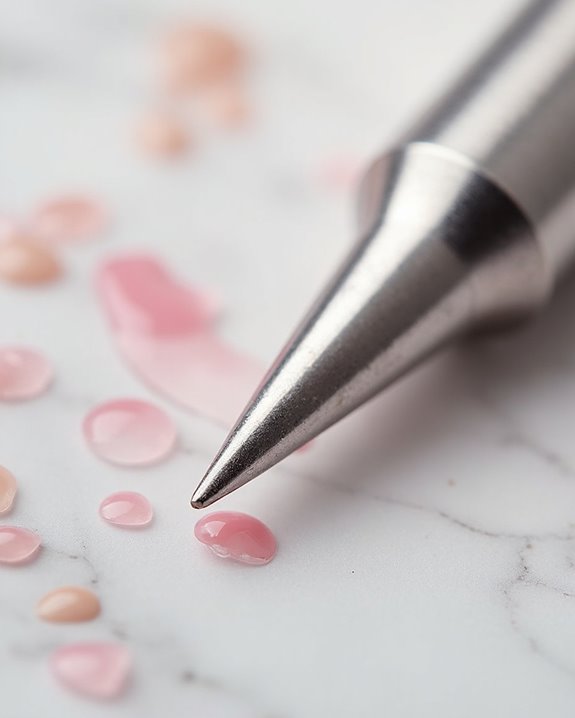Nail drill bits serve specific functions based on their shape, material, and grit level. Barrel bits handle surface work and shaping, while needle bits access tight spaces around cuticles. Materials range from durable carbide to precision diamond and heat-reducing ceramic, with standard 3/32-inch shanks fitting most handpieces. Choose coarse grits (80-120) for product removal and fine grits (240+) for polishing. Understanding the proper bit for each task guarantees safe, professional results for both natural and artificial nail applications.
Key Takeaways
- Barrel bits are versatile for surface work and shaping, while needle bits provide precision for cleaning sidewalls and tight spaces.
- Carbide bits offer durability for acrylic removal, while diamond bits excel at precision exfoliation tasks.
- Bit grit levels range from coarse (80-120) for product removal to fine (240+) for gentle smoothing and finishing.
- Safety bits with rounded tops protect sensitive areas, making them ideal for beginners and cuticle work.
- Bit maintenance requires thorough cleaning with brush, water, soap, and disinfectant soak after each use.
The Fundamentals of Nail Drill Bits
The essential components of nail drill bits form the backbone of any professional e-file system, providing technicians with precision tools for a variety of nail enhancements. These bits feature a standard 3/32-inch shank that secures into your hand piece, while the working head comes in numerous shapes like barrel, flame bit, and pointed designs to perform specific functions like buffing, shortening, or cuticle preparation.
Nail drill bits are manufactured from various materials, each with distinct advantages: carbide bits excel at durability when you need to remove acrylic, ceramic bits reduce heat during prolonged use, and diamond bits offer versatility for clean, precise work. All professional-grade bits are acetone-proof, enabling proper disinfection between clients—just remember to clean your bits thoroughly after each use to maintain their effectiveness and guarantee hygienic practice.
Proper grit selection is crucial, with coarse grits (80-120) ideal for shaping and fine grits (240+) perfect for polishing.
Types of Materials Used in Nail Drill Bits

Selecting the right material for your nail drill bits can dramatically impact both your technique and client comfort, as each material type brings distinct advantages for specific nail enhancement procedures. Carbide nail drill bits offer exceptional durability and reusability, maintaining sharpness through repeated acrylic removal sessions. Diamond bits, with actual diamonds embedded on their surface, provide superior precision for exfoliation tasks. Ceramic bits feature specialized fluted teeth that minimize heat generation during operation, making them ideal for sensitive nail work.
For versatility, consider a Mandrel bit made of metal or rubber to hold fabric sanding bands of varying grits. These interchangeable sanding bands allow you to quickly shift between fine, medium, or coarse textures when prepping nails, giving you flexibility while maintaining professional results with different materials of nail drill accessories.
Tungsten carbide bits are highly recommended for their long-lasting sharpness, enabling salon-quality precision in acrylic applications.
Understanding Bit Shapes and Their Specific Functions
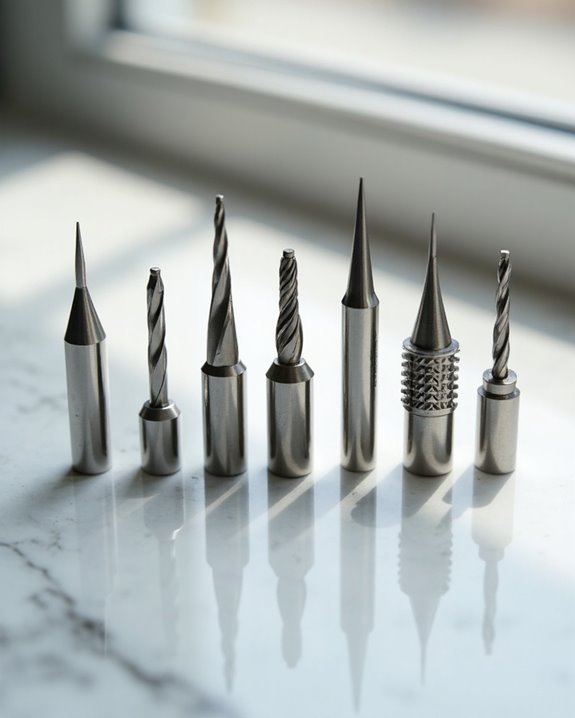
Why do nail technicians need a variety of differently shaped drill bits? Different shapes serve distinct purposes in nail care, allowing for precise work across various techniques. Barrel bits, available in large and small sizes, excel at surface work like backfill cutting and shaping while avoiding the cuticle area. For cleaning sidewalls and accessing tight spaces, needle bits with their fine, pointed tips provide excellent precision. Ball top bits are essential for removing loose cuticle above the nail plate, while cone bits excel at cuticle preparation and cleaning under the nail. When working near sensitive areas, safety bits offer protection with their rounded tops. Understanding these specialized shapes guarantees you’re using the right tool for each task, preventing damage to the natural nail while achieving professional results. Flame-shaped bits enable safe and precise cuticle work, making them essential for home users seeking salon-quality results.
Grit Levels Explained: From Coarse to Fine
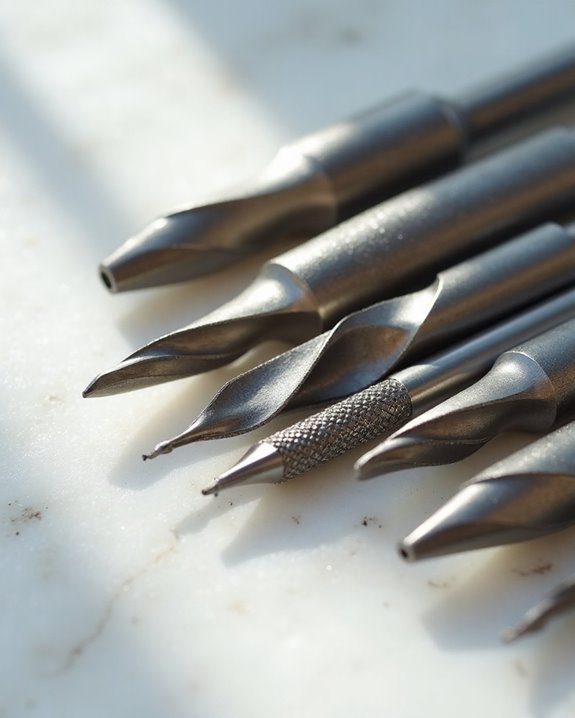
Just as sandpaper comes in various grades for woodworking, nail drill bits feature different grit levels that determine their abrasiveness and appropriate applications. Understanding these variations helps you select the right bit for each nail service task.
Coarse grit bits, like the Barrel Coarse and Smooth Top Coarse, contain larger abrasive particles ideal for quick removal of acrylics, dip powder, and gels when shortening is needed. Medium grit bits offer balanced abrasiveness for controlled product removal without damaging natural nails. Fine grit bits, with their smaller particles, provide gentle smoothing with minimal heat buildup, perfect for finishing touches on sensitive nails. The grit level is determined by particle size and density per square inch—coarser grits have fewer, larger particles, while finer grits contain more, smaller particles for precision work.
Essential Bits for Professional Nail Technicians

Now that you’re familiar with grit variations, we’ll focus on the professional-grade bits every nail technician should have in their toolkit. The carbide barrel bit is indispensable, allowing you to remove product efficiently without damaging natural nails through 150-300 services with proper care.
Invest in a versatile 5-in-1 nail drill bit that handles multiple functions including cuticle cleaning, nail bed preparation, and shaping. Large barrel bits with flat tops are essential for backfill cutting and shortening acrylics while maintaining safe distance from cuticles. For delicate work around nail sidewalls, safety bits with rounded tops prevent injury while providing precise control. Complete your collection with specialized options like the tapered barrel for tight corners and flame bits for detailed work—these essentials will dramatically improve your service speed and quality.
Safe Techniques for Using Different Nail Drill Bits
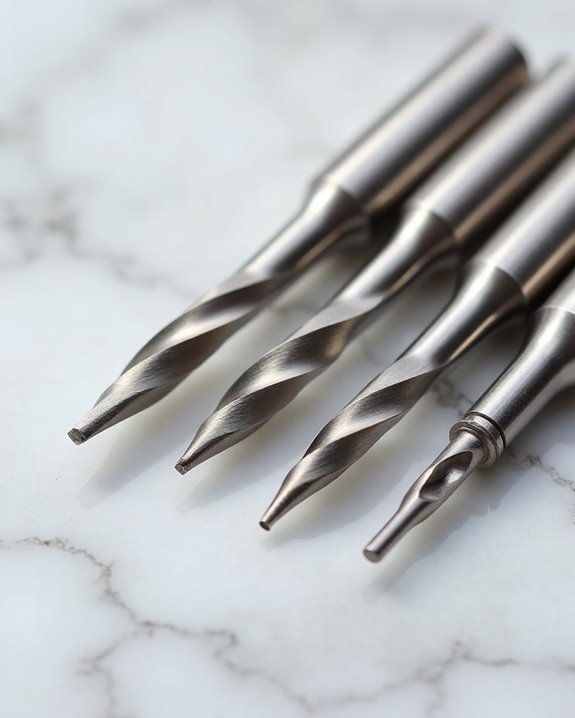
Safety precautions form the foundation of professional nail drill use, protecting both you and your clients from potential injuries during service. Always rest your operating hand on a stable surface while working, which prevents damage to natural nails and avoids lifting of the nail plate. Select the appropriate level of grit for each task—medium and coarse bits for product removal, fine texture bits for finishing work near cuticles. Bits rounded at the top are safest near sensitive areas, greatly reducing risks of burning or cutting delicate skin.
Before inserting any bit, turn off your e-file completely and make sure it clicks securely in place. After each client, maintain sanitation by first using a cleaning brush to remove debris, then soak metal bits in liquid disinfectant for 1-2 minutes without damaging their effectiveness.
Proper Maintenance and Sanitization Practices
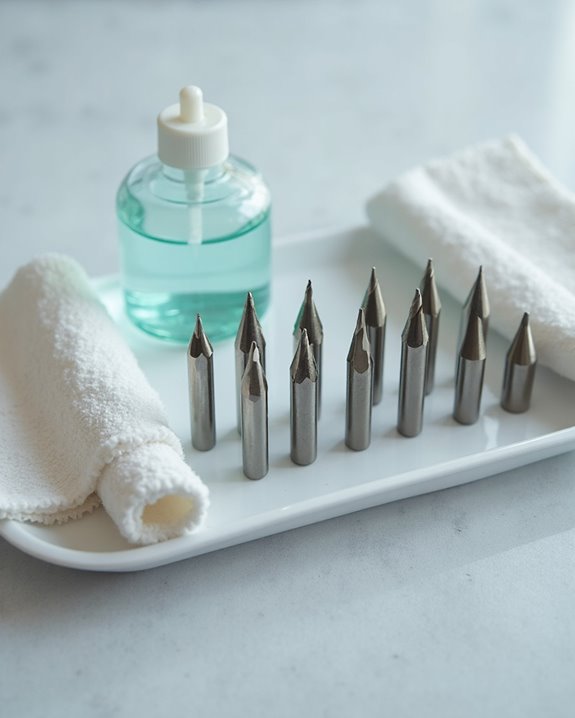
Maintaining your nail drill bits properly extends their life and protects your clients’ health, forming the cornerstone of a professional nail technician’s routine. After each service, thoroughly clean your bits with a brush, warm water, and soap to remove debris without damaging your clients’ nails. For metal carbide and ceramic bits, implement a two-step process: nail cleaning with soap followed by a 1-2 minute soak in alcohol, perfect for cleaning without compromising the High Quality of your Nail Tools. Always dispose of sanding bands after single use, as they can’t be properly sanitized. When performing cuticle work, make sure to inspect bits for damage and store cleaned bits in a proper case. Pre-soak in acetone for initial cleaning, then immerse bits in a liquid disinfectant before UV sterilization to guarantee your client’s nails remain infection-free.
Best Bits for Natural vs. Artificial Nail Applications
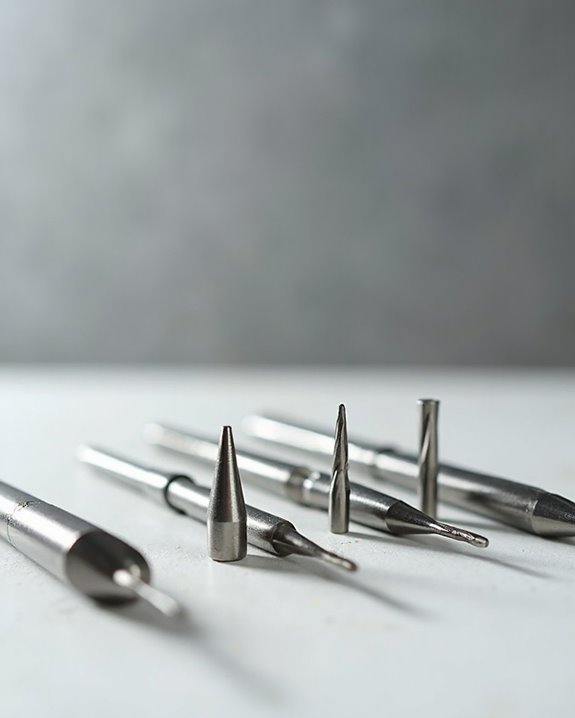
Choosing the appropriate drill bits for different nail applications can make all the difference in your service quality and client satisfaction. For natural nails, use fine grit bits like the Sm Tapered Barrel, which provides gentle exfoliation and precise cuticle care without damaging delicate nail beds. Safety bits with rounded tops are particularly ideal for beginners working on natural nails.
In contrast, artificial nail services require coarser options to effectively tackle tougher materials. Medium to coarse carbide bits, such as the Lg Carbide Barrel, work efficiently on acrylic and gel enhancements. For versatility with artificial applications, the 5-in-1 bit excels at multiple tasks including product removal and smoothing. Remember that your drill speed should correspond to your bit choice—lower RPMs for fine bits on natural nails, higher speeds for coarse bits on artificial enhancements.
Specialty Bits for Advanced Nail Art and Designs
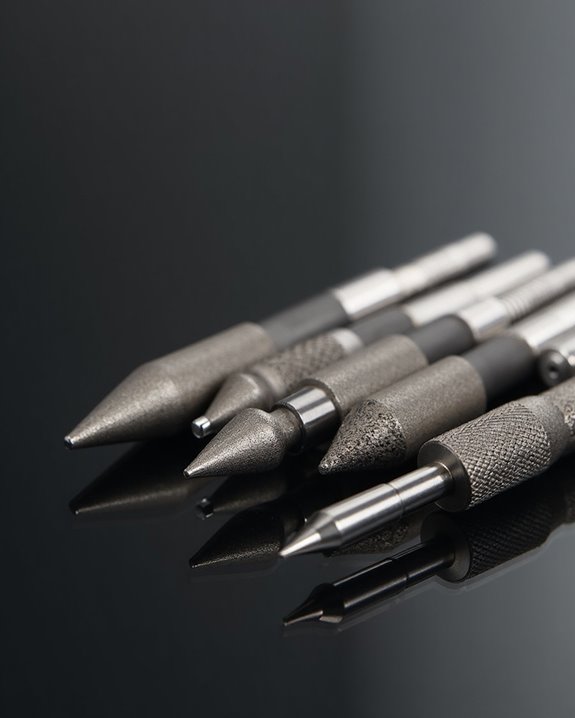
Advanced nail artistry demands precision tools that can transform ordinary manicures into miniature masterpieces, and specialty bits are the secret weapons in a professional’s arsenal. The UNC bit, with its pointed, tapered shape, excels at creating designer holes in nails and accessing tight spaces like sidewalls without damaging delicate areas. For versatile applications, you’ll find the 5-in-1 bit indispensable for preparing nails for detailed designs. Diamond and Russian Flame bits, featuring tapered edges, allow you to work meticulously around the cuticle area without damaging tissue, providing the perfect canvas for nail art. When you need to remove gel products efficiently, Flame Carbide bits offer the durability and precision required, ensuring a smooth surface for your artistic creations.
Frequently Asked Questions
What Drill Bit Do You Use to Shape Nails?
For shaping nails, you’ll need barrel bits (large or small), diamond, or tapered varieties. Expert advice suggests maintaining proper speed control and bit maintenance while integrating safety measures to prevent common errors during your creative designs.
What Different Nail Drill Bits Are For?
You’ll need various bits for: acrylic filing with barrel bits, gel removal with coarse bits, cuticle care with safety bits, design tips with needle bits, and polishing with smoothing bits. Always adjust speed and follow safety protocols.
How Do I Know Which Drill Bits to Use?
You’d think it’s rocket science, but it’s not! Match your selection criteria to usage scenarios—consider shape, grit level, material match, and your experience. Beginners should start with medium grits and adjust speed accordingly.
What Is a Drill Bit Guide?
A drill bit guide is a resource that helps you select, use, and care for your bits. It’ll cover safety measures, material types, maintenance tips, compatibility checks, and may include brand comparisons and innovation trends.

